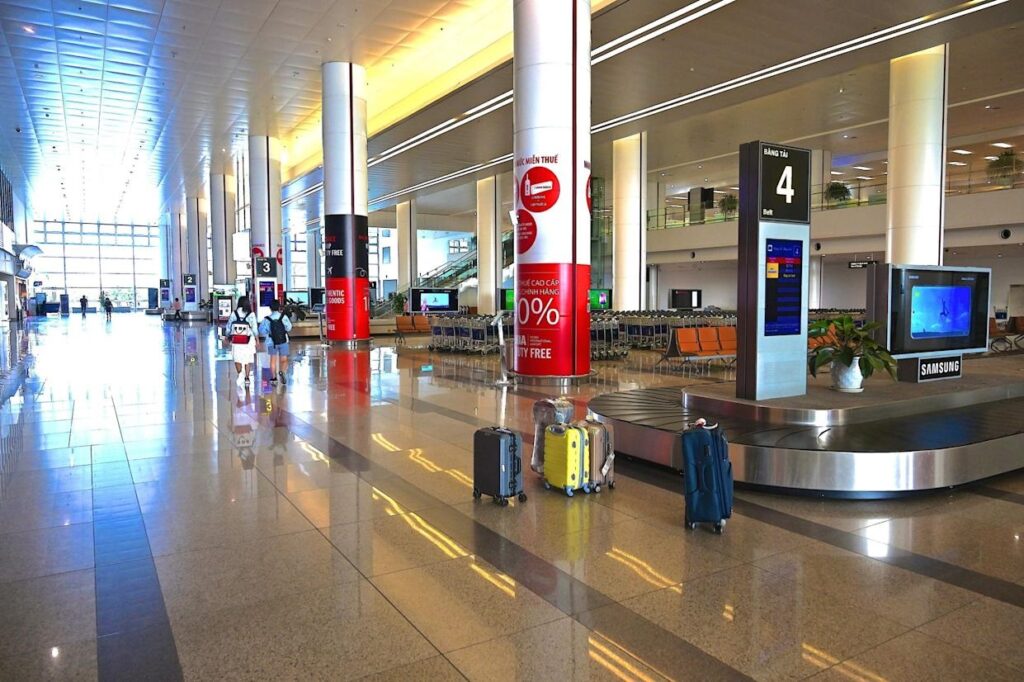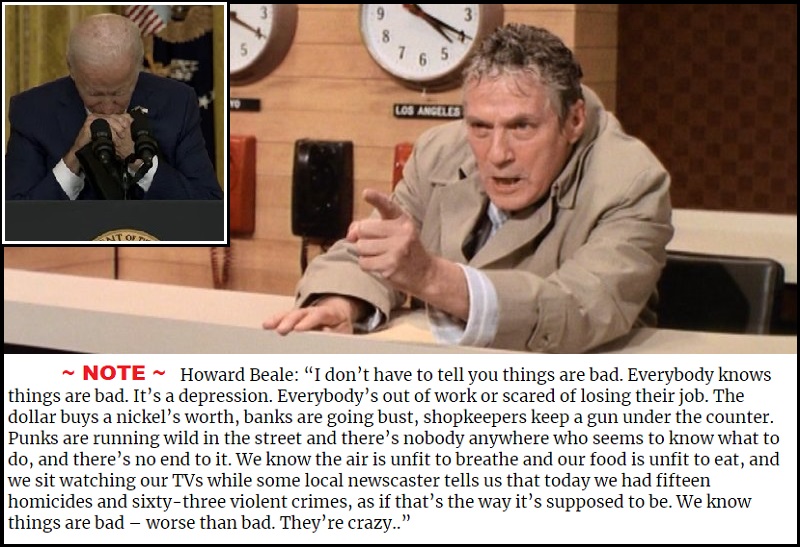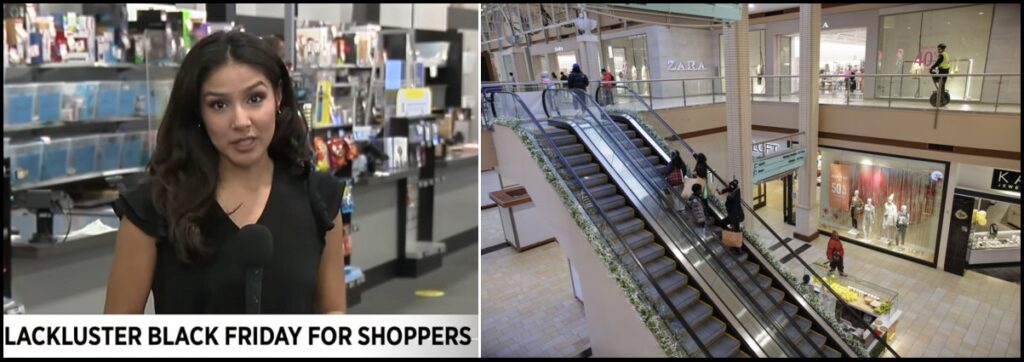There is something predictable about Main Street economics, eventually what you see around you overwhelms the great pretending. CTH has been outlining the state of the consumer economy in great detail for quite a while, and though it is difficult to note when the outcomes will surface, eventually they do surface. [Reminder Here]
CONTEXT. CTH outlined the moment when the purchasing power of the U.S. middle class actually began contracting. It was March and April of 2021 when that Rubicon was crossed. We saw it in the second and third quarter data from 2021, but few were willing to admit.
What changed in those two months back in ’21 was a dramatic drop in the “unit sales” of stuff within the consumer economy. The drop in unit sales was hidden because it happened simultaneously with the first wave of massive spike in prices. Prices rose so fast the sales data was giving an artificial impression of sales growth, but in the background the actual unit sales dropped. Those analysts correcting and adjusting historic data to ‘inflation adjusted terms’ are now noticing.
Additionally, and not coincidentally – because the metrics are connected, you will note this line from the Wall Street Journal review of the producer price index. “The producer-price index, which generally reflects supply conditions in the economy, rose 6.2% in December from a year earlier, the Labor Department said Wednesday, the slowest annual pace since March 2021.” In essence, the current rate of wholesale price increase on materials is now returning to the rate of price increase that happened in the period when prices spiked. Again, this is predictable.
 Inflation is the measure of the ‘rate’ of price increase over time. March and April of 2021 were the beginning of the first inflationary spike.
Inflation is the measure of the ‘rate’ of price increase over time. March and April of 2021 were the beginning of the first inflationary spike.
Driven almost entirely by the supply side shock from Biden energy policy, in the subsequent 20 months the rate of price increase skyrocketed, peaked August 2022, and now the rate of increase starts returning. This does not mean price declines; this means the rate of growth in the price increase is lessening.
This is a cyclical outcome.
After 20 months of dropping unit sales, a result of massive price increases; and as the rate of inflation now starts to moderate created by the cyclical nature of it; what we now see is the inability of the price increases to continue hiding the drop in unit sales. [Background pdf Data] Total retail sales data is now exposed and that’s why we will see this increasing story about negative sales data as the inflation cycle plateaus.
(Via Wall Street Journal) – Retail spending fell in December at the sharpest pace of 2022, marking a dismal end to the holiday shopping season as rising interest rates, still-high inflation and concerns about a slowing economy pinched American consumers.
Purchases at stores, restaurants and online, declined a seasonally adjusted 1.1% in December from the prior month, the Commerce Department said Wednesday. Sales were also revised lower in November and have fallen three of the past four months.
The decline in retail spending late last year adds to signs that the U.S. economy is slowing. Hiring and wage growth eased in December, U.S. commerce with the rest of the world declined significantly in November, and existing-home sales have fallen for 10 straight months. The Federal Reserve said Wednesday that industrial production slumped in December, led by weakness in the manufacturing industry.
S&P Global downgraded its estimate for fourth-quarter economic growth by a half percentage point to a 2.3% annual rate after Wednesday’s data releases. Economists surveyed by The Wall Street Journal this month expect higher interest rates to tip the U.S. economy into a recession in the coming year.
“The lag impact of elevated inflation weighs heavily on U.S. households, it’s very clear that the median American consumer is still reeling from the loss of wages in inflation-adjusted terms,” said Joseph Brusuelas, chief economist at RSM US LLP. “We’re moving towards what I would expect to be a mild recession in 2023,” he added. (read more)
When the Baghdad Bob economic pretenders say, “mild recession,” anticipate something more akin to a mild nuclear meltdown, something with breadlines and soup kitchens.
Now, you must keep in mind that almost every financial media outlet used the same Retail Federation talking point about anticipating an 8% increase in holiday sales last year. [Reminder] Apparently, collective pretenses must be maintained. Meanwhile, news crews and camera crews were having a desperate time finding any holiday shopping to use as background footage for the claims that sales were strong. Here we are in January and the pretending has hit reality.
Negative retail sales in November and December when prices are roughly +10% over the prior year, means the unit sales collapse was far more dramatic…. Far more.
Trying to survive policy driven price increases in housing costs, energy costs, electricity costs, home heating, food and fuel costs has forced consumers to reevaluate purchasing decisions. Consumer demand for non-essential items has collapsed, and Americans are dig deep into their savings just to sustain unavoidable expenses. Eventually, pretending this is not happening is going to run into the wall of reality.

On one hand the leaders of large multinationals must pretend everything is splendid; after all, the only acceptable position they can articulate is to support interest rates being raised because demand is just too darned high…. pretending. But on the other hand – those same suppliers and multinationals are furiously trying to calculate how to avoid being stuck with billions worth of unsold inventory and idle industrial equipment.

We have always been at war with East Asia.
Just completed my second peak-season as a UPS personal vehicle delivery driver in rural Minnesota…on my route deliveries were way down from last year. Despite the economic damage already done in 2021, that Christmas season half of my 40-50 stops had 3-5 deliveries per week over five weeks. The 2022 season? Six…maybe.
Wasn’t the Christmas season pre-sold in August, September and October amid the scare headlines of supply line shortages?
I clearly remember the economic pundits urging to shop “now” and get it while you can. Consumer purchases in September went up 0.6% Y/Y. So, what was left for December?
You’re pretending too
IMO yes I agree but also consider that these retailers have a better understanding of financial policy and how to manipulate it to the advantage…….
They knew, rather, that We the People would have extremely limited resources for holiday shopping.
IMO in August, September and October….they were viciously competing for the limited dollars known as ‘discretionary income’. I seriously doubt the supply chain was as big of a deal as it was said to be.Captialism at its fiercest!
“They” want your dollars, any way “they” can grab them.
Well, these globalists went along with the corrupt politicians so let them absorb their inventories.
I do business with large paper mills. Two of those in my area have the appearance of being nearly at a standstill. I asked, one said “it’s bad”. So their union member employees vote Blue, and the business volume collapses. More pretending.
I’m trying desperately to stay out of the stores. I’m dropping $200 each time I go in. It was $100 a short time ago (when the real President was in office), and I was able to buy twice as much goods.
All this misery brought to us by the Fake President and his Posse.
Retail sales drop….ya think?
Now, my fellow Treepers know how I harp on the real estate markets….new home buyers, first time buyers, down sizers, and up scalers….
There is always a lot of purchasing done around a home…be it an old one like mine, fondly called the ‘money pit’..People spend a lot of $$$ on their home, especially when moving to a new abode. Furniture, curtains, new dishes, towels, drapes and curtains…new toys for the kids etc….
Not to mention the multiple annoying trips to the hardware store for the right size nails, screws, hammers and other widgets… that you don’t have and desperately need…then lawn care….
And that blurb above, describes Chicago…only they throw more money at the problem.
In the end, retail sales and real estate have a symbiotic relationship…..wondering how that unsold inventory is going to hold up….
I often wonder what happens to it, when HD and Loews cannot unload it all….
I remember during the ’08-’09 Repression I bought my $300 Queen Palm trees (1-2 years old) for a mere $60 each at HD. That’s how they do it!
Here’s the quote in this article that will be lifted out of context: “The rate of inflation has started to moderate.”
Kareenm Hyphen Moptop will credit Biden with cooling down our economy and protecting the middle class, all accomplished by his policy prowess.
Wait for it.
Kareenm Hyphen Moptop: good name.
If they supported this nonsense in any sense of the word, then they deserve to go under. No sympathy.